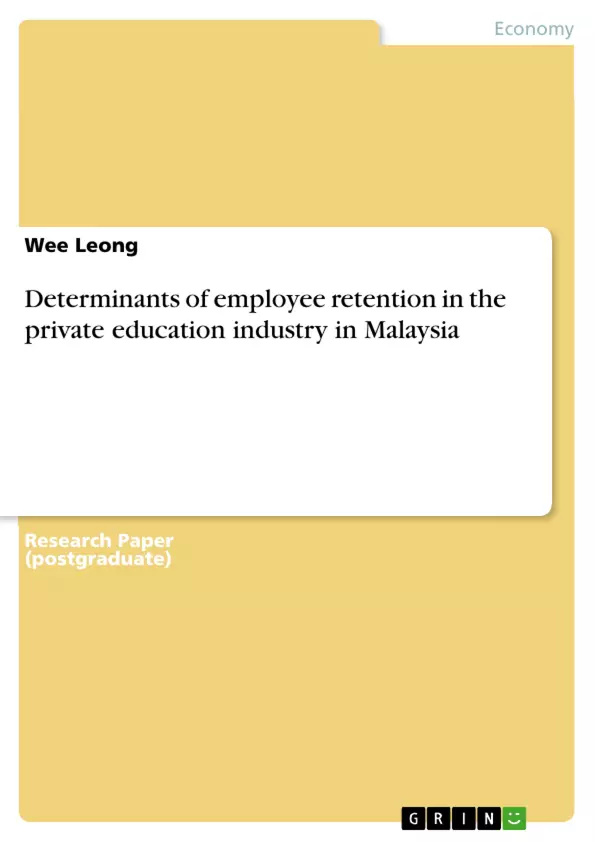This work aims to investigate the intrinsic and extrinsic factors that contribute to organizational commitment in the private education industry in Malaysia, to identify how employee retention programs can be effectively implemented in this industry, and to develop and empirically test a model of organizational commitment towards employee retention in the private education industry in Malaysia.
Based on the identification of intrinsic and extrinsic factors in the private education industry in Malaysia, this work used a questionnaire to assess the Malaysian private education industry in terms of its cognition and perspective with regard to intrinsic and extrinsic factors that lead to organizational commitment and its organizational commitment toward achieving an effective employee retention program. A questionnaire survey method was used to collect primary data from emails that were sent to participants. The research findings revealed that intrinsic and extrinsic factors and organization commitment were significantly and positively related to employee retention. Based on the research results, the author discusses managerial implications of the findings and opportunities for future research.
In today’s highly competitive business environment, organizations regardless of their sizes are facing employee retention challenges. Human resources are directly or indirectly related to all organizational processes and thus are important in allowing an organization to gain and sustain a competitive advantage. However, just to ensure employees stays on a payroll is meaningless, the company must also find out why employees stay.
Inhaltsverzeichnis (Table of Contents)
- ABSTRACT
- INTRODUCTION
- LITERATURE REVIEW
- THE NEED TO RETAIN CRITICAL EMPLOYEES
- THEORETICAL BACKGROUND
- ORGANIZATIONAL COMMITMENT
- HERZBERG'S MOTIVATOR-HYGIENE THEORY
- EQUITY THEORY
- EXPECTANCY THEORY
- SIDE-BET THEORY
- INTRINSIC AND EXTRINSIC FACTORS ON ORGANIZATIONAL COMMITMENT
- Promotion
- Employee Rewards: The Importance of Perceived Fairness
- Working Conditions
- Employee Training & Development
- Career Advancement Opportunities
- Respect and Recognition
- Organizational Empowerment
- Job Security
- Pay Satisfaction
- Organization's Reputation
- EMPLOYEE RETENTION
- PRIVATE EDUCATION INDUSTRY AND EMPLOYEE TURNOVER RATE IN MALAYSIA
- THEORETICAL FRAMEWORK
- THE MEASUREMENT MODEL
- RESEARCH POPULATION AND INSTRUMENTATION
- DATA ANALYSIS
- RESULTS
- SUMMARY AND CONCLUSIONS
- RECOMMENDATIONS FOR FUTURE RESEARCH
- REFERENCES
- Intrinsic and extrinsic factors influencing organizational commitment.
- Employee retention programs and their effectiveness.
- The relationship between organizational commitment and employee retention.
- Application of theoretical frameworks, including expectancy theory, equity theory, the motivator-hygiene theory, and side-bet theory.
- The impact of employee turnover and its costs on the private education industry in Malaysia.
- Introduction: The chapter highlights the significance of employee retention and discusses the challenges faced by organizations in retaining their workforce. It introduces the research objective and outlines the theoretical framework that will guide the study.
- Literature Review: This chapter delves into the existing literature on employee retention, exploring various theoretical perspectives including organizational commitment, motivation theories, and the impact of intrinsic and extrinsic factors. It also discusses the importance of retaining critical employees and the associated costs of employee turnover.
- Private Education Industry and Employee Turnover Rate in Malaysia: This chapter provides a contextual background for the study by examining the specific characteristics of the private education industry in Malaysia and its challenges in retaining employees. It explores factors contributing to employee turnover in this sector.
- Theoretical Framework: This chapter outlines the theoretical framework adopted for the study, detailing the proposed model of organizational commitment towards employee retention. It describes the variables and relationships examined within the model.
- The Measurement Model: This chapter presents the measurement model developed for the study, explaining the measurement instruments used to assess organizational commitment, employee retention, and the identified factors.
- Research Population and Instrumentation: This chapter describes the target population for the study, outlining the sample selection process and the instruments used to collect data through the questionnaire survey.
- Data Analysis: This chapter explains the statistical techniques and methods employed to analyze the collected data, focusing on how the relationships between variables were investigated.
Zielsetzung und Themenschwerpunkte (Objectives and Key Themes)
This study aims to investigate the factors that contribute to organizational commitment in the Malaysian private education industry, identify effective employee retention programs, and develop a model of organizational commitment towards employee retention in the industry. The study utilizes a questionnaire survey to gather data and employs statistical analysis and structural equation modeling to analyze the relationship between identified factors and employee retention.
Zusammenfassung der Kapitel (Chapter Summaries)
Schlüsselwörter (Keywords)
This study focuses on key concepts related to employee retention in the private education industry in Malaysia. These concepts include intrinsic factors, extrinsic factors, organizational commitment, employee retention, side-bet theory, equity theory, motivator-hygiene theory, and expectancy theory.
- Citar trabajo
- Dr. Wee Leong (Autor), 2019, Determinants of employee retention in the private education industry in Malaysia, Múnich, GRIN Verlag, https://www.grin.com/document/511366



